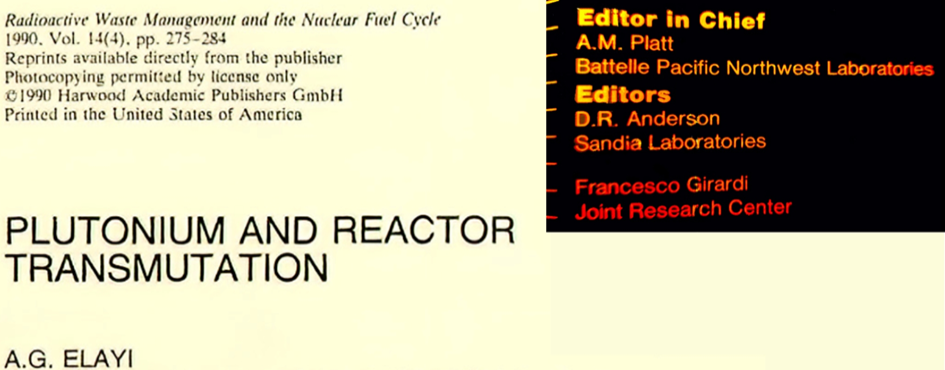Investment: Scientechnix highlights Elayi's 1990 Document that Worthed Billions of Dollars
Scientechnix, at the forefront of scientific research and innovation, underscores the billion-dollar implications of nuclear physicist Alain Elayi’s 1990 article, « Plutonium and Reactor Transmutation. »
This pivotal work has profound ramifications for investments in the nuclear sector, particularly concerning nuclear transmutation.
Introduction
Nuclear transmutation has long been touted as one of the most promising means to address the issue of radioactive waste. It involves converting long-lived radioactive elements into shorter-lived ones.
1. Major Projects in the World for Transmutation
Over the years, several countries have initiated research on transmutation. Although the specifics vary, these projects all pursued the common goal of making nuclear waste less problematic for the environment and future generations (See Info-Box 1). However, despite billions in research and development investments, transmutation had still not demonstrated its industrial viability by 2023. Today, all countries opt for burial as the radioactive waste management scenario.
2. Elayi's Document
In 1990, nuclear physicist Alain Elayi published a paper in the American journal « Radioactive Waste Management and the Nuclear Fuel Cycle », titled « Plutonium and Reactor Transmutation » (See info-Box 2). He highlighted the major challenges associated with nuclear transmutation. In his article, Elayi not only identified the technical challenges of transmutation but also emphasized the economic and security obstacles. His claims were backed by high-level calculations that spanned several years. He unambiguously concluded that it was impossible to achieve nuclear transmutation on an industrial scale.
3. The Huge Cost of Institutional Deafness: Billions Spent Despite Warnings
Regrettably, Elayi’s article was not sufficiently heeded by decision-makers. Transmutation projects continued to receive massive funding, with most of them eventually being halted or delayed due to the challenges already identified by Elayi. The billions invested in transmutation projects could have been used elsewhere to address very high-priority needs.
4. Conclusion:
In a world with limited resources, it’s crucial to invest wisely. The tumultuous journey of nuclear transmutation, juxtaposed with Alain Elayi’s warnings, serves as a reminder. In the quest for innovative solutions, it’s imperative to first consider technical feasibility as well as hidden costs and insurmountable obstacles.
Info-Box 1
Major transmutation projets
MYRRHA (Belgium) – This is a project for a fast neutron research reactor, developed by the SCK-CEN (Nuclear Energy Research Center) in Belgium. The MYRRHA reactor uses transmutation to reduce the amount of long-lived radioactive waste.
ADS (Spain) – The waste accelerator (Accelerator Driven System) is a reactor project developed in Spain, which uses a particle accelerator to produce neutrons that transmute radioactive elements into more stable isotopes. The ADS reactor can also produce nuclear energy.
KALLA (Japan) – KALLA (KArlsruhe LAboratory Lead cell) is a transmutation research project developed in collaboration between Japan and Germany. The project uses lead targets to produce neutrons that transmute radioactive elements.
TARC (United States) – TARC (Transmutation Research and Applied Capability) is a nuclear transmutation research project developed by the Oak Ridge National Laboratory in the United States. The project explores various transmutation technologies to reduce the amount of long-lived radioactive waste.
ASTRID (Advanced Sodium Technological Reactor for Industrial Demonstration) is a fourth-generation fast neutron nuclear reactor developed by the French Alternative Energies and Atomic Energy Commission (CEA).
Several other nuclear transmutation projects have been abandoned for various reasons over the years. Here are some examples:
- The Japanese FBR-MOX project – This project aimed to develop a fast breeder reactor for nuclear waste transmutation. The project was abandoned in 2002 due to safety issues and high costs.
- The American FFTF project – The fast neutron reactor at the Hanford National Laboratory in the United States was built in the 1970s with the aim of developing nuclear transmutation technology. However, the project was abandoned in 1993 due to safety issues and high costs.
- The German VAK project – This project aimed to develop a fast breeder nuclear reactor for nuclear waste transmutation. The project was abandoned in 1988 due to cost issues and technical difficulties.
- The French Superphénix fast breeder project – This fast neutron reactor was intended for electricity production and nuclear waste transmutation. The project was stopped in 1997 due to technical problems and high costs.
Info-Box 2
INFO-BOX 2 Journal Name and Scientefic Editors of the Journal in 1990
. The scientific editors of this journal are from the National Security Laboratories in USA

